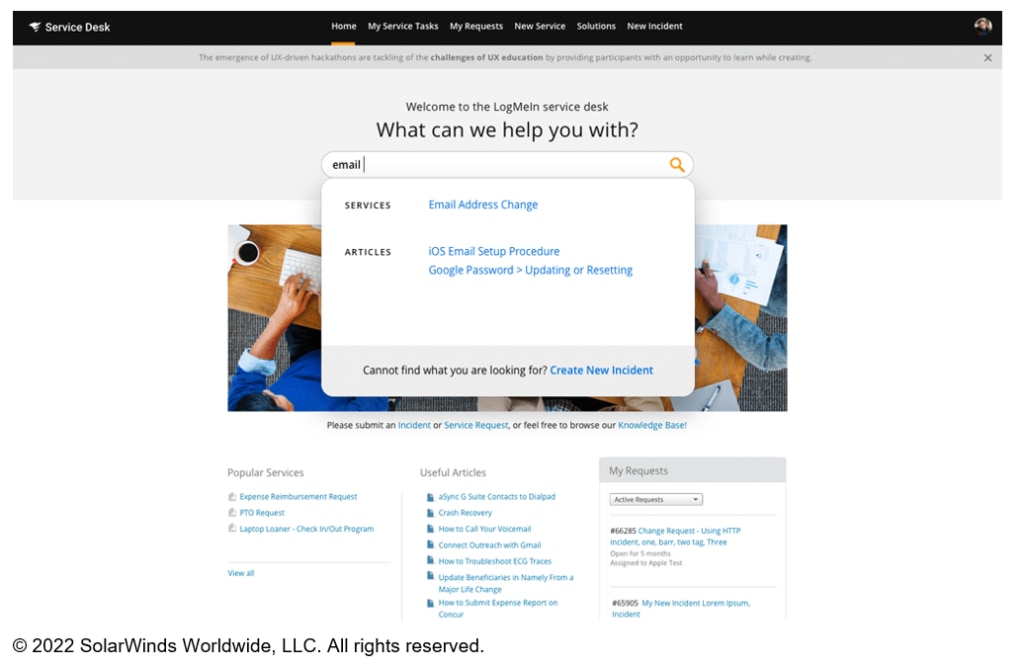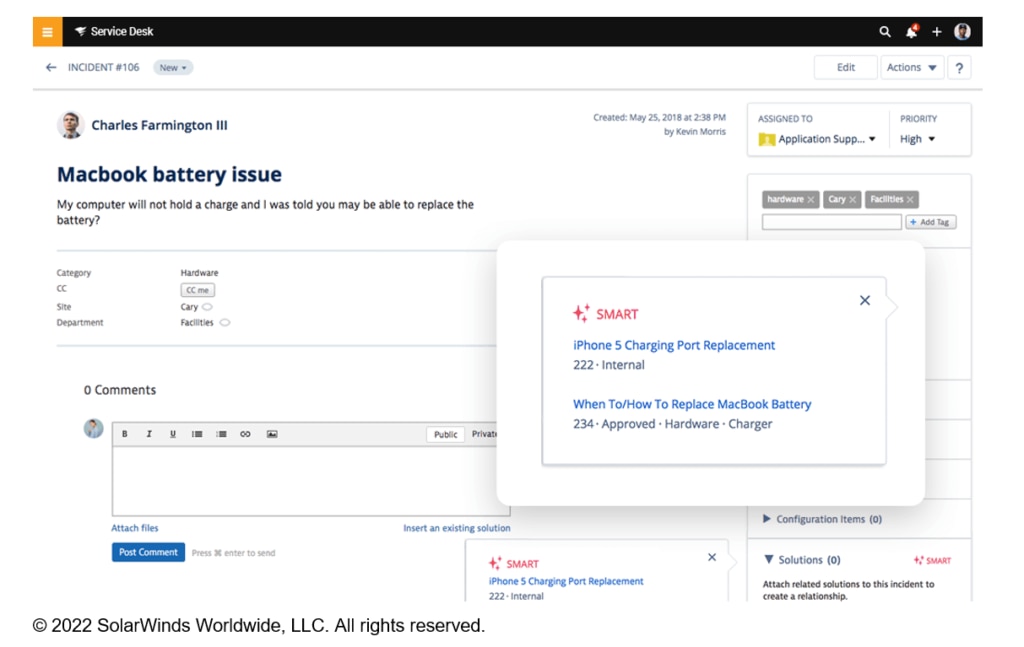The IT Infrastructure Library (ITIL) describes a framework for delivering IT services according to best practices, including best practices for what’s known as knowledge management.
Knowledge management, which includes being able to gather, store, and share IT knowledge, is critical for IT service management (ITSM). With dedicated tools, service teams can find everything they need to know about how to effectively implement IT services, ultimately saving time, effort, and money by gathering all the information about an organization’s systems and processes in one easily accessible space.
Here’s everything you need to know about ITIL knowledge management best practices to streamline your organization’s data and plan for future growth. And to help implement these best practices, you can consider a tool like SolarWinds® Service Desk, designed to boost and and end-user productivity.
What Is ITIL Knowledge Management?
Why Does Your Business Need Knowledge Management ITIL?
What Are the Components of a Service Knowledge Management System?
What Are Some ITIL Knowledge Management Best Practices?
What Tools Can Help Improve My ITIL Knowledge Management
What Is ITIL Knowledge Management?
Simply put, knowledge management involves collecting, analyzing, storing, and sharing all of an organization’s IT information in one location. The knowledge included in this space will relate both to an organization’s systems and processes, along with information about employee skills, typical user behavior, the structure of an organization, and information about individual suppliers, along with a host of other resources.
Maintaining a healthy and functional knowledge management ITIL system isn’t only critical for the organization and growth planning of a business but also for creating value within the organization, saving time and effort by giving employees easy access to reliable, accurate information.
This access is ideally provided by a service knowledge management system (SKMS), which ensures the correct information reaches the right employees whenever they need it.
Why Does Your Business Need Knowledge Management ITIL?
To effectively implement services, both admins and end-users need access to SKMS. No matter what services a business provides, employees need a database outlining best practices for everything from customer service to employee training programs. Maintaining a functional SKMS helps employees to better understand and perform in their roles and helps drive customer satisfaction by creating an easily accessed standard for the entire business.
Additional reasons to create and update a knowledge management ITIL resource are to increase customer satisfaction while decreasing costs. Making relevant parts of a business’s SKMS available within a self-help user portal cuts down on the amount of time a service desk has to spend answering questions, especially if a self-help portal includes a detailed list of frequently asked questions.

What Are the Components of a Service Knowledge Management System (SKMS)?
A good SKMS will not only provide a place to store an organization’s data but will also be easily searchable, making it possible for employees to instantly find the expert or company knowledge they’re looking for to efficiently perform their roles. Here are a few of the most important components of a good service knowledge management system.
Content Management System (CMS)
A CMS acts as a hub for storing documentation and data. The CMS should be accessible to all employees and should also be easily searchable, with the storage capacity for large amounts of data with plenty of room for growth. In particular, Configuration Management Databases (CMDBs) contain essential information around configuration data, including all information about hardware and software assets.
Expertise Databases
Collecting information around the skills and roles of each team member in an organization and then collating this data into an employee directory enables employees to quickly find subject matter experts within the company.
Lesson Learned Information
It can make sense to offer the team an easily searchable guide to established best practices and expertise. Collecting it all within an SKMS standardizes and captures this information, helping to not only improve employee performance but also reduce critical and costly errors.
What Are Some ITIL Knowledge Management Best Practices?
Decide what knowledge is most useful
Instead of gathering any and all knowledge into an overwhelming mass of data, think strategically about exactly what knowledge might be most useful. To make this decision, perform a knowledge gap analysis, which will help form a guide to precisely what information employees need to best perform their roles. This analysis will also help provide information about what employees already know to avoid redundancy. Additionally, it may be helpful to research commonly asked questions, take an inventory of commonly used search terms, and collect information about potential areas of improvement from customer surveys.
Create a system for storage and organization
Once you’ve collected all of the potentially useful data for your knowledge base, think carefully about how this information will be stored and organized in order to make it both easily accessed and user-friendly. Make sure your SKMS also has adequate backup and room to add more data as the organization grows.
Provide training around using your knowledge base
The best-maintained knowledge base is still not correctly functioning if employees don’t understand how to use it. Make sure your knowledge base isn’t merely available but easy to understand as well. Some helpful tools for promoting literacy include diagrams, tutorial videos, webcasts, graphics, and images, among others.
Keep your knowledge up to date
Building a successful SKMS isn’t a one-time process—it’s an ever-evolving system involving frequent audits of the information included within the SKMS. Make sure you’re routinely culling outdated information while updating your records with your organization’s plans for growth, new hire information, and best practices for customer service. It’s also important to note how employees are using your SKMS, addressing any pain points along the way.
What Tools Can Help Improve My ITIL Knowledge Management?

SolarWinds Service Desk is a modern IT service management solution helping eliminate barriers to employee support services. Service Desk offers a knowledge base enabling your employees to better access the support service they need while providing the flexibility to plan, review, and implement changes quickly and successfully. With a robust knowledge management ITIL system, you’ll be able to ensure your employees have an easy path to the help they need with vital information about your organization at their fingertips. There’s even a version of the knowledge base which makes information available to customers so they can solve some of their own IT issues. Start your 30-day free trial today.